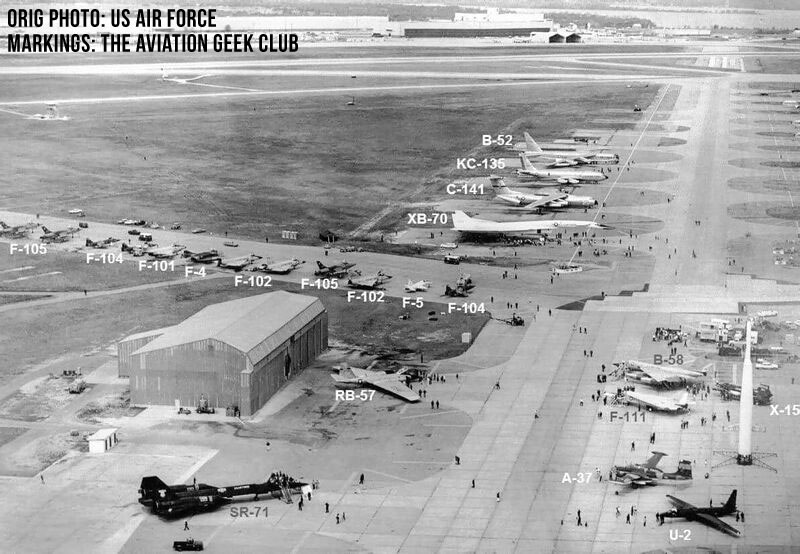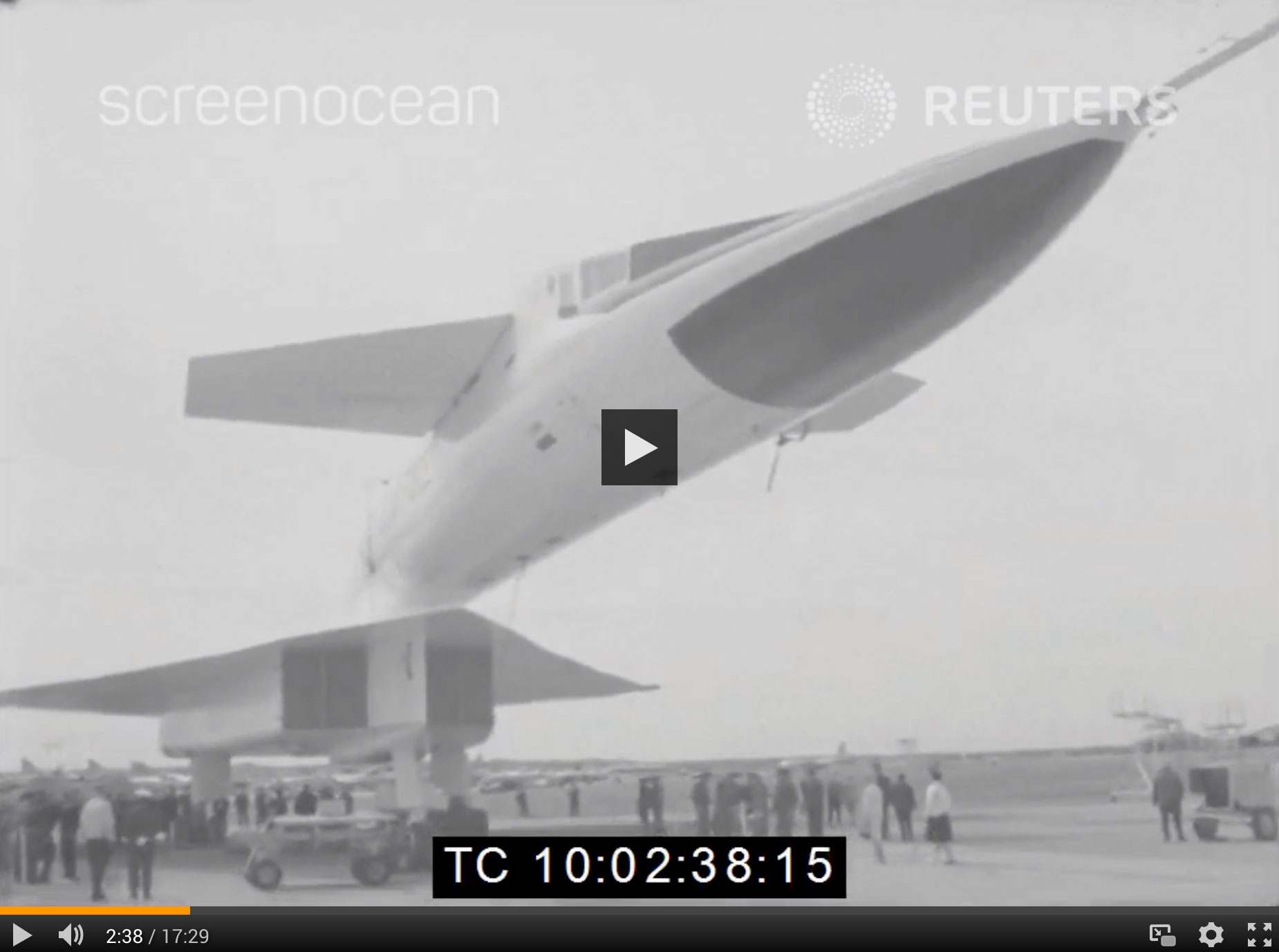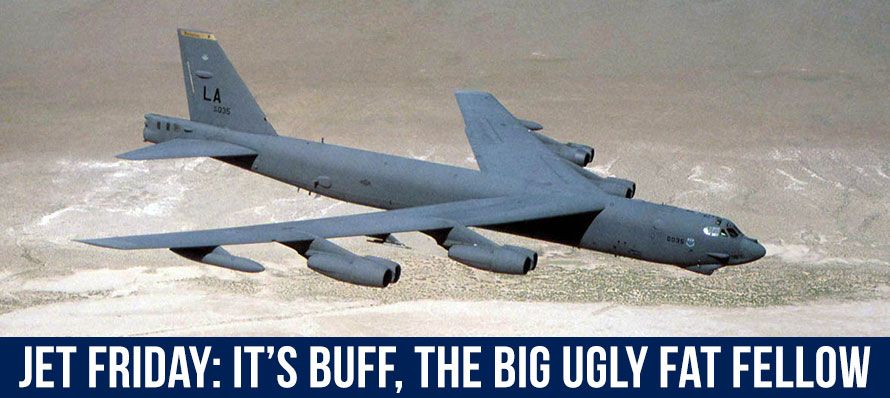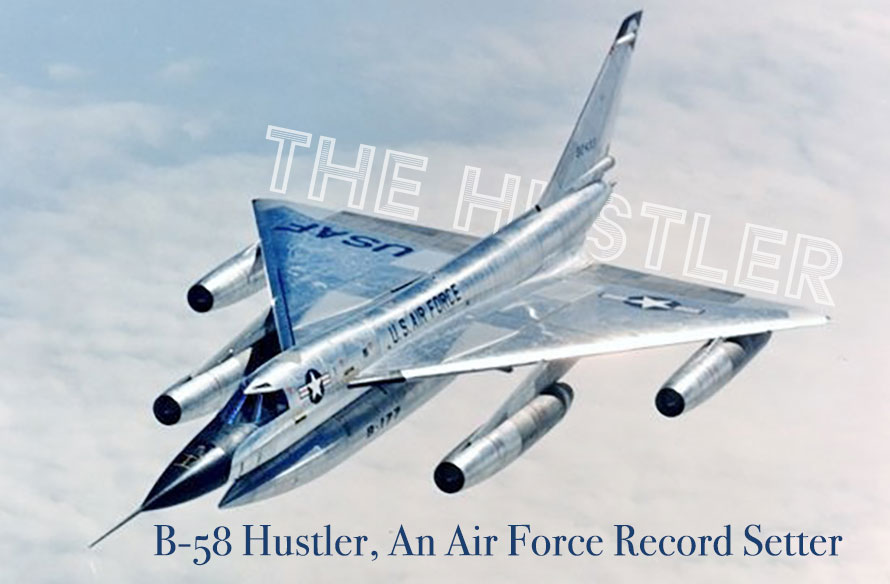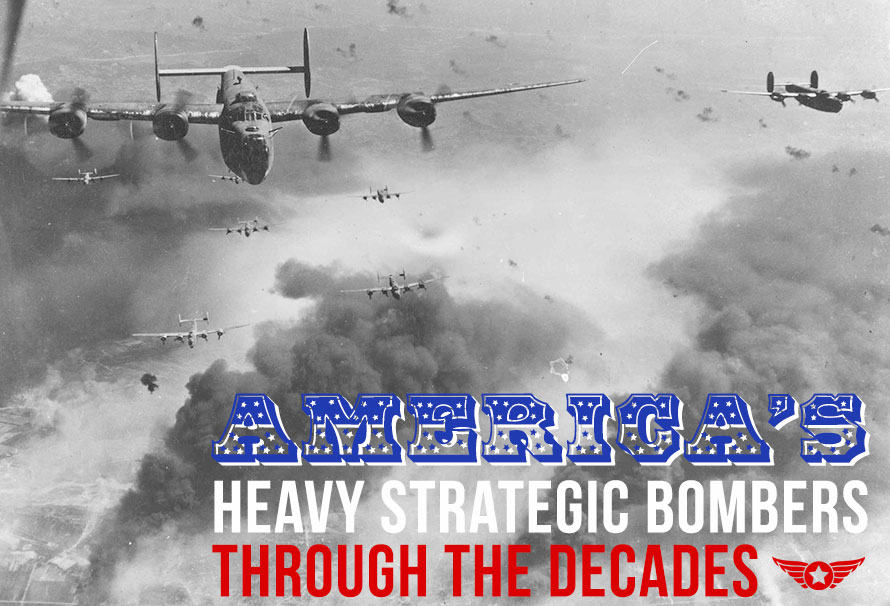Some of the most powerful and unique aircraft from the Cold War era are featured on this runway in North Texas. This static display of United States military might was held in March 1966 during an airshow hosted by Carswell Air Force Base (AFB).
Located just northwest of Fort Worth, TX, Carswell AFB was named after a B-24 Liberator bomber pilot and native of Fort Worth, Major Horace S. Carswell. Carswell was awarded the Medal of Honor for his actions following an attack on a 12-ship Japanese convoy, which saved the lives of most of his crew but resulted in his death as his plane crashed into a mountain. Before its closure in 1991, the airbase’s mission was to train and support heavy bomber groups, and was one of the first Strategic Air Commands (SAC) in the U.S. Today it is called Naval Air Station Joint Reserve Base Fort Worth – home to reserve air units of the Air Force, Navy, Marines Corps, and Air National Guard.
One of the most unique aircraft in the photo is the XB-70 Valkyrie. The XB-70 Valkyrie was the largest and fastest strategic bomber the United States ever built. It was designed to exceed Mach 3, or over 2301 mph, and had a service ceiling of over 77,000 feet. It performed these speeds and reached these altitudes using six General Electric afterburner turbojet engines, each producing 30,000 lbf of thrust. Just a few months later in June, the Valkyrie would be destroyed, along with an F-104 Starfighter, in a tragic mid-air collision during an unauthorized photo shoot.
Also read: Unauthorized Photo Session Kills Pilots, Destroys Experimental Aircraft
Here is a brief description of the aircraft in the photo.
A-37 Dragonfly – The Cessna A-37 Dragonfly was introduced during the Vietnam War and remained in peacetime service afterward. It’s a twin-engine American light attack aircraft with tandem seats for the pilot and co-pilot or training pilot. It was developed from T-37 Tweet basic trainer. To get the Dragonfly ready to be a combat aircraft, it needed to gain some weight. Improvements would be stronger wings, three additional weapons pylons on each wing, larger wingtip fuel tanks, and better avionics for navigation and targeting. A 7.62 mm Gatlin-style machine gun was added to the nose of the aircraft with a capacity of 3,000 rounds/minute. With these upgrades, the A-37 could fly lower and slower over a target to provide excellent close-air support.
B-26K Counter Invader – Or the A-37 in the picture is more likely a B-26K, which was an iconic twin-engined light bomber and ground attack aircraft born in WWII. In the 1950s, it roared above the Korean skies to disrupt North Korean supply lines as a night intruder, and then was reassigned in the 1960s in Vietnam where its eight .50 caliber nose guns were used for powerful ground attacks along the Ho Chi Minh Trail with up to 8 tonnes of mixed ordnance payload capacity – truly remarkable firepower!
B-52 Stratofortress – The B-52 is a long-range, subsonic, jet-powered strategic bomber powered by eight turbofans. The B-52 is officially known as the Stratofortress. This behemoth of the sky has other unofficial nicknames given by the pilots that fly them. The B-52 is quite large with a length of just over 159 feet long and a wingspan of 185 feet wide. Because of its massive size, the B-52 has a nickname among U.S. Air Force personnel as “BUFF” which is short for “Big Ugly Fat F*****” or to some, Big Ugly Fat Fellow.
Also read: It’s BUFF, The Big Ugly Fat Fellow
B-58 Hustler – The first bomber to fly at Mach 2, the Hustler was designed for high-speed, high-altitude penetration missions to deliver a nuclear payload. This sleek-looking supersonic delta wing bomber was powered by 4 afterburner turbojet engines that propelled it to a max speed of 1,319 mph. It was extremely fast for its time. Setting 19 world record speed records, in March of 1962 a B-58 crew set a record for a non-stop round trip from Los Angeles to New York and back to Los Angeles in a time of 4 hours, 41 minutes, and 14.91 seconds, at an average of 1,044.46 mph.
Also read: The Hustler – An Air Force Record Setter
C-141 Starlifter – The C-141 Starlifter ushered in a new era of fast and efficient transport for the US military with its four turbofans providing remarkable acceleration, topping out at 567 mph. Put into service as an upgrade to traditional propeller aircraft such as the Douglas C-124 Globemaster II or Douglas C-133 Cargomaster, this powerful airlifter set a precedent that revolutionized modern cargo transportation.
See Infographic: Compare the USAF Cargo Aircraft C-5 C-17 C-130 Infographic
F-101 Voodoo – With its powerful supersonic speeds, the F-101 Voodoo was a revolutionary fighter bomber and reconnaissance aircraft. Its advanced weapons bay could house up to four AIM-4 Falcon missiles or two AIR Genie rockets cleverly concealed within its sleek airframe using a rotating door, ready for deployment at any given moment.
F-102 Delta Dagger – During the Cold War, the F-102 Delta Dagger was ready to take swift action against any invading Soviet strategic bomber fleets. Designed specifically for combating Tupolev Tu-95s and other prominent bombers of its era, this aircraft provided a powerful defensive layer in international airspace.
F-104 Starfighter – The F-104 Starfighter was a supersonic interceptor designed without a lot of extra interior frills. It was armed with a 20mm Gatling autocannon. Initially, it carried two sidewinders on the wing tips, but eventually, they added more pylons under the wings and body. The F-104 was not an air-to-air dogfighter. It was designed to get off the ground and climb quickly at a rate of 48,000 ft/min to intercept incoming bombers, strike, and then get away.
Also read: Missile With a Man In It – the F-104 Starfighter
F-105 Thunderchief – The F-105 was designed to fly fast at very low altitudes, penetrate contested air space under the radar, and deliver a nuclear payload housed internally. When the F-105D served in Vietnam, its primary mission was to deliver heavy bombs against all military targets but it became dedicated to locating and destroying the SAM sites so that American aircraft could get through to their bombing missions.
Also read: The Vietnam Pilot Who Earned the MOH in a THUD.
F-106 Delta Dart – The United States Air Force relied on the sophisticated Delta Dart interceptor to take out enemy bombers. Built for optimum speed and efficiency, its sleek aerodynamics housed weapons in an internal bay. It had no need for a gun or external armaments – this formidable craft was exclusively designed to tackle aerial threats.
Also read: The Unmanned Jet Landing that Didn’t Start Out As A UAV
F-111 Aardvark – Introduced into service in 1967, the F-111 Aardvark was an impressive supersonic medium-range multirole combat aircraft with variable-sweep wings, afterburning turbofan engines, and automated terrain-following radar that enabled it to fly at low altitudes. Its versatility as a multipurpose combat platform allowed for roles including strategic bombing, ground attack interdiction, reconnaissance, and electronic warfare – all propelled by two powerful after-burning turbofan engines!
F-4 Phantom II – The F-4 Phantom II, a two-seat, twin-engine, all-weather, long-range supersonic jet, fit that need perfectly. With a top speed of 1,472 mph (Mach 2.23), the Phantom II was the fastest interceptor aircraft/fighter bomber of its time. With the thrust from two General Electric J79-GE-17A axial compressor turbojets, the F-4 allowed a pilot to engage and disengage his opponent at will during aerial combat. During Vietnam, it was the principal air superiority fighter for both the Navy and Air Force.
Also read: The PHantastically PHast F-4 PHantom!
F-5 Tiger II – The F-5’s original mission was to be a superior daytime air-to-air fighter and did not even include a radar. In the beginning, it fulfilled a limited air-to-ground role. It would eventually be fitted with an APQ-153, designed to fit the tight confines of a radarless nose cone, providing the Tiger II with simple air-to-air modes and a short detection range. Powered by two compact, high thrust-to-weight ratio turbojet engines, its maximum speed is Mach 1.6, or 1,060 mph.
Also read: 5 Fast Facts of the F-5 Tiger II
KC-135 – This U.S. Air Force aerial refueling aircraft was introduced into service in 1957, and flown primarily by the United States, France, Turkey, and Singapore. Capable of carrying 200,000 lb of fuel, the Stratotanker can refuel aircraft using either a flying boom or its shuttle-cock drogue.
Also read: Aging Refueler Could Reach Century Mark Before Retiring From Service
RB-57 Canberra – This Cold War-era bomber is a remarkable feat of engineering, boasting two turbojets that propel it to record speeds of 570 mph. Its various weapons systems can launch an impressive 5,000 pounds worth of bombs from its bomb bay and eight rockets each from four separate wing pylons – all controlled by four 20 mm cannons or .50 caliber machine guns!
SR-71 Blackbird – As a reconnaissance plane that flew missions during the Cold War across foreign lands like Russia to find out just what they were up to, a pilot needed something that flew high and flew fast. With the ability to cruise at +2,200 MPH in excess of 80,000 ft, the SR-71 easily fulfilled that mission. It was a stealth aircraft, but If it was detected by a Surface-to-air (SAM) missile site, by the time the SAM was able to lock on, the SR-71 was well out of range. When preparing for a mission, the aircraft would actually leak its JP-7 fuel as it sat on the runway. Because it flew so fast and experienced extreme friction heat, the fuel cells would expand during flight and seal the leaking fuel cells. It would only be partially fueled prior to takeoff to reduce stress on the aircraft’s tires. The reduced weight in fuel also provided assurance that the Blackbird could continue takeoff even if it lost one engine.
Also read: Black(bird) Friday…the SR-71 Blackbird Has Jet Friday Going Mach 3!
X-15 – The X-15 was a remarkable feat of engineering, pushing the boundaries beyond Earth’s atmosphere and capturing vital data to shape future aircraft and spacecraft models. In 1967, it reached record speeds of 4,520 mph at an altitude of over 100,000 feet – taking aviation history into new territory.
U-2 Dragon Lady – The U-2 Spy Plane, also known as The Dragon Lady, has a unique history. It is the reason there is a secret military base called Area 51. In 1955, the U-2 was authorized by President Eisenhower for development. The U.S. government needed a location not easily accessible by civilians or spies. They chose a very remote area in the desert near a salt flat called Groom Lake.
Also read: The U-2 Spy Plane, Difficult to Fly, Land, and Launch
Watch a Video from the 1966 Carswell AFB Aerospace Days Air Show Schedule
Lifecycle Extension
A qualified Depot Level Maintenance (D-Level) facility can eliminate the need to scrap repairable equipment by identifying the faults in malfunctioning equipment and repairing them quickly. With aging equipment, supporting technical data can be nonexistent, stopping repairs in their tracks. Finding a qualified depot that has the ability to reverse engineer obsolete technology and remanufacture unavailable parts is essential to returning functional mission-critical systems back to aircraft and ground systems.
Military Electronic Repair Services
As a D-Level Maintenance facility and qualified repair station, Duotech provides Military Electronics Repair Services. Duotech provides a full range of military equipment repair services, including a wide variety of electronic and electromechanical systems, communications and RF, and power systems. With over 35 years of industry experience, Duotech Services, LLC. maintains AS9100D and ISO 9001 certifications with the scope of repair, design, production (including CNC machining and laser cutting), testing, and overhaul services.
Contact Duotech Services today about your MRO needs. Duotech has the capability to repair thousands of different items. Begin your search for you Part Number here or request a Quote for Repair now.

